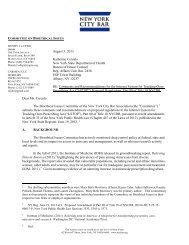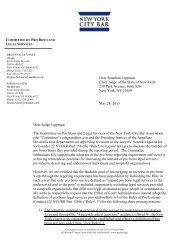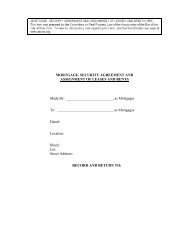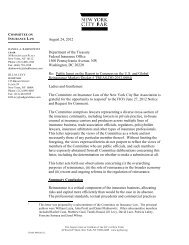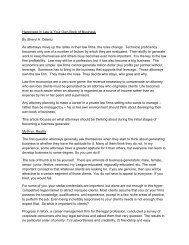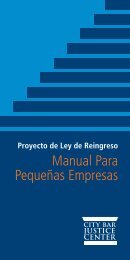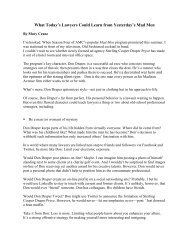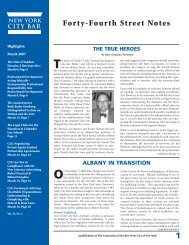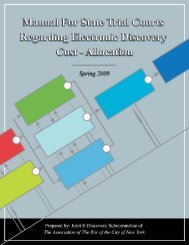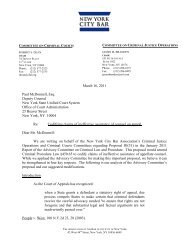2007 Issue 1 - New York City Bar Association
2007 Issue 1 - New York City Bar Association
2007 Issue 1 - New York City Bar Association
Create successful ePaper yourself
Turn your PDF publications into a flip-book with our unique Google optimized e-Paper software.
H E R M A N G O L D M A N L E C T U R E<br />
Part I of the paper describes the Panel’s proposal and the arguments it<br />
advanced in favor of the proposed change. Part II sets forth a model by<br />
which the Panel proposal will be evaluated. Part III compares the simplicity<br />
arguments for each of the two international tax regimes. In Part IV,<br />
the efficiency arguments advanced for each system are considered. Part V<br />
analyzes the equity issues under each system. Part VI sets forth my own<br />
conclusions on the issues.<br />
I.<br />
The Panel recommended that the current U.S. international tax regime<br />
be replaced with a two-part system:<br />
1. Foreign active business income, as well as dividends from<br />
foreign subsidiaries out of such income, would be exempt from<br />
U.S. income tax.<br />
2. Current U.S. income tax would be imposed on passive income<br />
and so-called mobile income (including, for example, financial<br />
services business income); a foreign tax credit would be<br />
allowed against the U.S. tax, with all such income being placed<br />
in a single basket. 5<br />
in a Global Setting, 57 Nat’l Tax J. 937 (2004), advanced a new criterion, that of “ownership<br />
neutrality.” That concept was sharply critiqued by Harry Grubert as lacking any “conceptual<br />
basis” and as of no use in addressing “any relevant policy issue.” See comment of Harry<br />
Grubert, 58 Nat’l Tax J. 263 (2005). I find the Grubert analysis persuasive and will not<br />
employ the ownership neutrality concept in this paper. See also the critique of the concept by<br />
Fleming and Peroni, note 3, at 235-239.<br />
Finally, I do not employ the criterion of “international norms,” as was done, for example, by<br />
the Treasury Department in its study of subpart F. See United States Department of the<br />
Treasury Office of Tax Policy, the Deferral of Income Earned Through U.S. Controlled Foreign<br />
Corporations: A Policy Study (2000). The problem is that supposed “norms” change. For<br />
example, prior to the issuance of the first set of regulations under I.R.C. § 482 in 1968, there<br />
was no international consensus and hence no norm about the comparable uncontrolled price<br />
method to be used in the arm’s length pricing methodology. Some 25 years later, when the<br />
Treasury issued proposed regulations, setting forth the largely formulary profit split and<br />
comparable profits methods, there was an outcry from many OECD countries that the international<br />
norm of arm’s length transfer pricing was being violated by the new rules.<br />
5. Panel Report at 240. The Panel Report closely parallels a report prepared by the Staff of the<br />
Joint Committee on Taxation, “Options to Improve Tax Compliance and Reform Tax Expenditures,”<br />
JCS-02-05 (Jan. 27, 2005) at pp. 186-198 (hereinafter JCT Staff Report). This discussion<br />
will include references to that study and notes any differences between the Panel Report and<br />
T H E R E C O R D<br />
72



